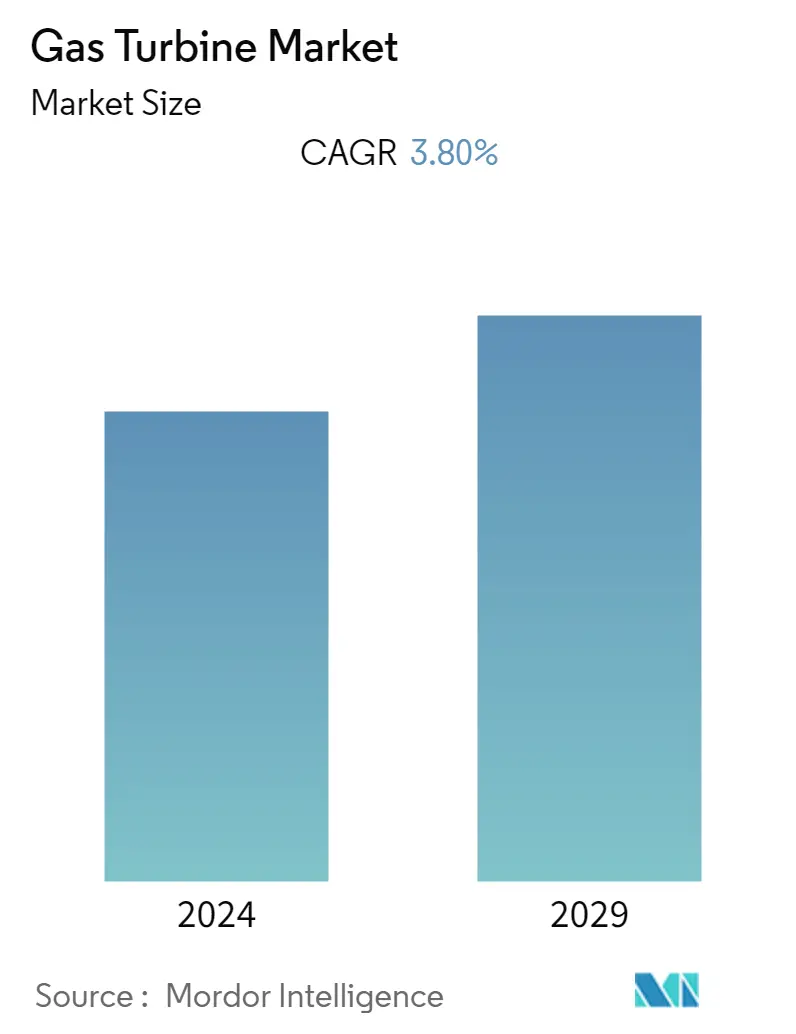Market Size of Gas Turbine Industry

| Study Period | 2020 - 2029 |
| Base Year For Estimation | 2023 |
| Forecast Data Period | 2024 - 2029 |
| CAGR | 3.80 % |
| Fastest Growing Market | Asia Pacific |
| Largest Market | Asia Pacific |
Major Players
*Disclaimer: Major Players sorted in no particular order |
Gas Turbine Market Analysis
The gas turbine market is expected to register a CAGR of approximately 3.8% during the forecast period. Global electricity demand is increasing, and it doubled within the last two decades. It is expected to grow at twice the pace of energy demand as a whole, in the next 25 years. Moreover, the advancement in technology leading to the increase in shale gas production, along with the plans of various countries to phase out coal-based power generation and replace them with the gas-fired power plant, is likely to act as a driver for the market. However, the increase in renewable deployment due to the enhanced efficiency of renewable-based power generation is expected to restrain the growth of the market.
- Generally, the turbine with a capacity above 120 MW is used for power generation. Turbines with a capacity of more than 120 MW are likely to dominate the market during the forecast period, with the demand for electricity expected to increase further.
- Moreover, the threat associated with the nuclear power plant is likely to promulgate the government's decision to prefer gas-based power generation over the nuclear power plant, which can provide an opportunity for the market growth during the forecast period.
- Asia-Pacific was the dominant region for the market in 2018, owing to the increasing reliance on gas-based power generation and an increase in oil and gas activities.
Gas Turbine Industry Segmentation
The gas turbine market report includes:
| Capacity | |
| Less than 30 MW | |
| 31-120 MW | |
| Above 120 MW |
| Types | |
| Combined Cycle | |
| Open Cycle |
| End-User Industry | |
| Power | |
| Oil and Gas | |
| Others |
| Geography | |
| Asia-Pacific | |
| North America | |
| Europe | |
| South America | |
| Middle-East and Africa |
Gas Turbine Market Size Summary
The gas turbine market is poised for steady growth, driven by the increasing global demand for electricity and the shift from coal-based power generation to gas-fired plants. Technological advancements in shale gas production and the phasing out of coal power are significant factors propelling the market. However, the rise in renewable energy deployment, due to its enhanced efficiency, poses a challenge to market expansion. Gas turbines, particularly those with capacities exceeding 120 MW, are expected to dominate the market, supported by the preference for gas-based power generation over nuclear options. The Asia-Pacific region, with its substantial reliance on gas-based power and burgeoning oil and gas activities, remains a key player in the market.
The global push to reduce carbon emissions has led to increased investments in gas-based power generation, particularly in China, where gas-fired capacity has surpassed coal for the first time. The cost-effectiveness and reliability of gas-based power generation compared to nuclear and renewable sources further bolster the demand for gas turbines. Despite being viewed as a transitional technology by EU policymakers, gas turbines are expected to play a crucial role in meeting energy demands while addressing environmental concerns. The market is characterized by fragmentation, with major players including General Electric Company, Siemens AG, and Mitsubishi Heavy Industries Ltd, among others, competing for market share.
Gas Turbine Market Size - Table of Contents
-
1. MARKET OVERVIEW
-
1.1 Introduction
-
1.2 Market Size and Demand Forecast in USD billion, till 2025
-
1.3 Recent Trends and Developments
-
1.4 Market Dynamics
-
1.4.1 Drivers
-
1.4.2 Restraints
-
-
1.5 Supply-Chain Analysis
-
1.6 Porter's Five Forces Analysis
-
1.6.1 Bargaining Power of Suppliers
-
1.6.2 Bargaining Power of Consumers
-
1.6.3 Threat of New Entrants
-
1.6.4 Threat of Substitute Products and Services
-
1.6.5 Intensity of Competitive Rivalry
-
-
-
2. MARKET SEGMENTATION
-
2.1 Capacity
-
2.1.1 Less than 30 MW
-
2.1.2 31-120 MW
-
2.1.3 Above 120 MW
-
-
2.2 Types
-
2.2.1 Combined Cycle
-
2.2.2 Open Cycle
-
-
2.3 End-User Industry
-
2.3.1 Power
-
2.3.2 Oil and Gas
-
2.3.3 Others
-
-
2.4 Geography
-
2.4.1 Asia-Pacific
-
2.4.2 North America
-
2.4.3 Europe
-
2.4.4 South America
-
2.4.5 Middle-East and Africa
-
-
Gas Turbine Market Size FAQs
What is the current Gas Turbine Market size?
The Gas Turbine Market is projected to register a CAGR of 3.80% during the forecast period (2024-2029)
Who are the key players in Gas Turbine Market?
General Electric Company, Siemens AG , Mitsubishi Heavy Industries Ltd , Mitsubishi Heavy Industries Ltd and Kawasaki Heavy Industries, Ltd are the major companies operating in the Gas Turbine Market.

